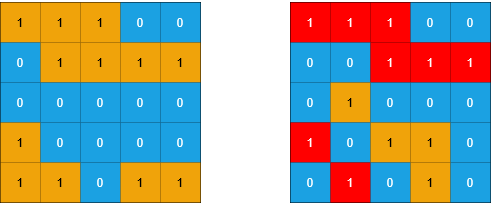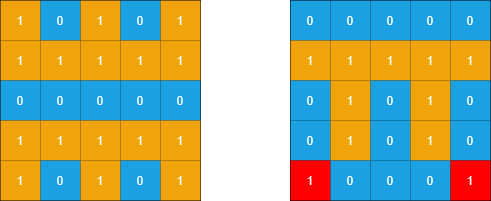1905. Count Sub Islands
Difficulty:Medium
Topics:Array, Depth-First Search, Breadth-First Search, Union Find, Matrix
You are given two m x n binary matrices grid1 and grid2 containing only 0's (representing water) and 1's (representing land). Anislandis a group of 1's connected4-directionally(horizontal or vertical). Any cells outside of the grid are considered water cells.
An island in grid2 is considered asub-islandif there is an island in grid1 that containsallthe cells that make upthisisland in grid2.
Returnthenumberof islands in grid2 that are consideredsub-islands.
Example 1:

- Input:grid1 = [[1,1,1,0,0],[0,1,1,1,1],[0,0,0,0,0],[1,0,0,0,0],[1,1,0,1,1]], grid2 = [[1,1,1,0,0],[0,0,1,1,1],[0,1,0,0,0],[1,0,1,1,0],[0,1,0,1,0]]
- Output:3
- Explanation:
- In the picture above, the grid on the left is grid1 and the grid on the right is grid2.
- The 1s colored red in grid2 are those considered to be part of a sub-island. There are three sub-islands.
Example 2:

- Input:grid1 = [[1,0,1,0,1],[1,1,1,1,1],[0,0,0,0,0],[1,1,1,1,1],[1,0,1,0,1]], grid2 = [[0,0,0,0,0],[1,1,1,1,1],[0,1,0,1,0],[0,1,0,1,0],[1,0,0,0,1]]
- Output:2
- Explanation:
- In the picture above, the grid on the left is grid1 and the grid on the right is grid2.
- The 1s colored red in grid2 are those considered to be part of a sub-island. There are two sub-islands.
Constraints:
- m == grid1.length == grid2.length
- n == grid1[i].length == grid2[i].length
- 1 <= m, n <= 500
- grid1[i][j] and grid2[i][j] are either 0 or 1.
Hint:
- Let's use floodfill to iterate over the islands of the second grid
- Let's note that if all the cells in an island in the second grid if they are represented by land in the first grid then they are connected hence making that island a sub-island
Solution:
We'll use the Depth-First Search (DFS) approach to explore the islands in grid2 and check if each island is entirely contained within a corresponding island in grid1. Here's how we can implement the solution:
Steps:
- Traverse the Grid:We'll iterate through each cell in grid2.
- Identify Islands in grid2:When we encounter a land cell (1) in grid2, we'll use DFS to explore the entire island.
- Check Sub-Island Condition:While performing DFS on an island in grid2, we'll check if all the corresponding cells in grid1 are also land cells. If they are, the island is a sub-island.
- Count Sub-Islands:For each island in grid2 that meets the sub-island condition, we'll increment our sub-island count.
Let's implement this solution in PHP:1905. Count Sub Islands
Explanation:
- DFS Function:The dfs function explores the island in grid2 and checks if the corresponding cells in grid1 are all land cells. If any cell in grid2 is land but the corresponding cell in grid1 is water, the island in grid2 is not a sub-island.
- Mark Visited:As we traverse grid2, we mark cells as visited by setting them to 0.
- Main Loop:We iterate through all cells in grid2. Whenever we find a land cell that hasn't been visited, we initiate a DFS to check if it's part of a sub-island.
Time Complexity:
The time complexity is (O(m times n)) where m is the number of rows and n is the number of columns. This is because we potentially visit every cell once.
This solution should work efficiently within the given constraints.
Contact Links
If you found this series helpful, please consider giving therepositorya star on GitHub or sharing the post on your favorite social networks ?. Your support would mean a lot to me!
If you want more helpful content like this, feel free to follow me:
The above is the detailed content of Count Sub Islands. For more information, please follow other related articles on the PHP Chinese website!







